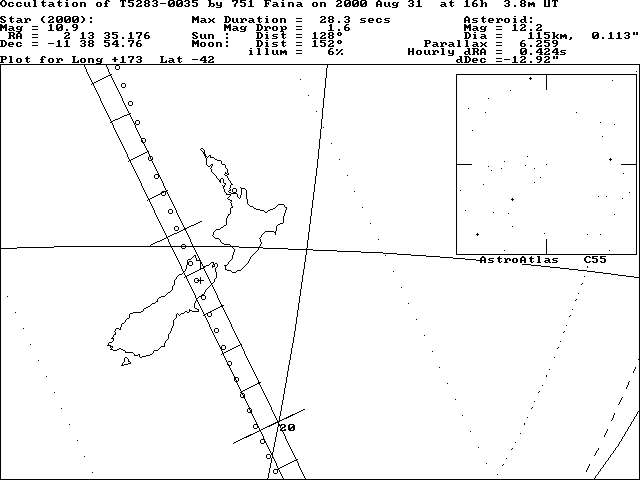ASTROMETRIC UPDATE:
OCCULTATION BY (751) FAINA - 2000 AUGUST 31
CHECK THIS PAGE REGULARLY FOR FURTHER UPDATES AND CHANGES TO THE TRACK.
YOU MUST RELOAD THIS PAGE USING YOUR BROWSER'S
RELOAD/REFRESH BUTTON TO OBTAIN UPDATES!
[Prediction by Edwin Goffin]
[Prediction using OCCULT software]
[Detailed finder chart by Jan Manek]
Goffin's path runs south through the Coral and Tasman Seas passing around 0.4" to the north east of Brisbane and 0.3" south west of Invercargill. The path given by OCCULT lies around 0.5" to the east and at a similar time. It crosses the South Isand of New Zealand from around Mt Cook to Dunedin. Observers should note that on the attached diagram, the small circles represent the centre line of the predicted path rather than the graduated line!
UPDATE: 24 August 2000
This prediction update has been computed by Jan Manek of the Stefanik Observatory based on astrometry from Ron Stone of the US Naval Observatory - Flagstaff Station. The newly available Tycho-2 position of the target star has been used rather than the original PPM position.
Summary:
This update indicates a shift in the predicted path to the north-east of around 1" and around 2.4 minutes later than as given by Edwin Goffin. The new path crosses the northern portions of the South Island of New Zealand around 16:16 UT. Christchurch and much of the western areas of the North Island including Wellington and Taranaki lie well within the error bounds for this calculation with expected times ranging from 16:15 UT to 16:17 UT.
Observers should note that the circles represent the true centre line of the update rather than the graduated lines !
The new Tycho-2 catalogue shows the target star to be around 1.5 magnitudes fainter than given in the PPM values in Goffin's prediction. This will reduce the magnitude drop to around 1.6 magnitudes - still well observable.
Observers should also note that the asteroid is moving slowly at the time of this event resulting in the longer than usual expected duration. For this reason, observers are urged to monitor this event for as long as practicable (at least 20 minutes) around the expected time of appulse.
THE EVENT AT ONE GLIMPSE:
- Date and approx. UT time of event: August 31, 2000 @ 16:16 UT
- Magnitude of target star: 10.9
- Magnitude drop [mag]: 1.6
- Estimated maximum duration [s]: 28.3
- Path description: See above.
- Goffin's original chart reference: A00_0828
The Occultation Path:
- Approximate width [km]: 120
- Uncertainty [path widths]: 1.8
- Uncertainty in time [s]: 55
- Map: See below
- Remarks: Uncertainities are given on the basis of the nominal star position errors and the expected asteroid positional accuracy.
- Circles along the path are OCCULT calculated exact centerline points !!!!
Data for the target star:
Data for the minor planet:
- Number, name: (143) Faina
- Approx. diameter [km]: 115
- Source of used astrometry: US Naval Observatory - Flagstaff Station (Ron Stone)
- Number of used observations: 43
- Number of rejected observations: 1
- Time covered by the observations: 1998 02 12 - 2000 08 17
- RMS residuals ["] (RA,DE): 0.09", 0.09"
- Estimated positional accuracy at epoch of event ["]: 0.14"
- The quality of this update is heavily dependent on the single 2000 position used.
Data for the event:
- UT date and time of least geocentric approach: 2000 August 31, 16:03.8 UT
- Approx. V mag of minor planet at event [mag]: 12.2
- Geocentric parallax of minor planet ["]: 6.529
- Magnitude drop [mag]: 1.6
- Estimated maximum duration [s]: 28.3
- Apparent motion of minor planet ["/h]: 14.35
- Angular distance to moon, phase of moon [deg,%]: 152, 6%
- Update computed by: Jan Manek, Stefanik Observatory, Prague, Czech Republic.

IMPORTANT NOTE!
Astrometric updates such as these should not be taken as definitive, but rather only as an indication of where the true track may lie relative to the original predicted track. Observers must bear in mind that later astrometry, in which the target star is measured in the same field as the asteroid, may still reveal substantial changes to the predicted track and time of the event. For this reason it is most important that observers far from the predicted track still monitor the event.
Use these links for further information:
[Planetary Occultations]
[Using the Predictions]
[Observing Details]
[Timing Details]
[Reporting Details]
[Report Form]
[Asteroid Occultation Results]
This page may have been updated since 24 August 2000.
Hit your browser's RELOAD button to get the latest version.
[Site Map]
[What's an Occultation?]
[Total Occultations]
[Grazing Occultations]
[Planetary Occultations]
[Jovian Satellite Eclipses]
[Timing Occultations]
[Reporting Observations]
[Coming Events]
[Software]
[About Us]
[Publications]
[Membership]
[Links]
[Top of Page][Return to Home Page]
